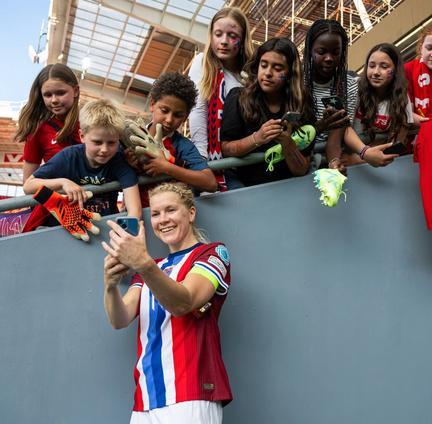A new era of success for Norwegian women's football

Why is this a priority?
Women's football has experienced explosive international growth recently, with increasing interest and professionalism. Norway has a long and proud history of pioneering international women's football, and we have high participation numbers in girls' football. While we take pride in our legacy, we must evolve to compete under new and tougher conditions. Many nations have made significant sporting and financial investments in women's football.
This will not hold us back—on the contrary, it will motivate us to find new competitive advantages that can lead to future successes and triumphs for Norwegian women's football.
Our goal for the upcoming strategic period is clear: We will increase the number of girls playing football and strengthen our international standing, both at the club level and with the national team. To succeed, we must develop girls' and women's football on their own terms, with an approach that meets their unique needs.
Girls' football
Football is by far the most popular sport for girls in Norway, with 124,000 active members. However, despite strong participation numbers, we have seen a decline in players aged 13–19 in recent years from an already vulnerable starting point. Overall, women's representation in football remains low, a trend we are determined to reverse.
Today, many girls who aspire to pursue football at a high-level experience significant pressure, while those who play primarily for social and recreational reasons often struggle to find stable teams. To address this, we must recruit more girls into football at an early age and ensure they stay in the game longer. At the same time, we must make a concerted effort to include more girls from multicultural backgrounds, ensuring that football remains an inclusive and welcoming community for all.
The popular UEFA Playmakers programme will be expanded and strengthened. In addition to introducing more new girls to football, over 1,000 young girls have already gained coaching experience through Playmakers. If we are to realise our ambition for Norwegian girls' and women's football, we must invest in coaching expertise—including increasing the number of female coaches. Only 13% (1 in 10) of all coaches are women.
The regional football associations will play a key role in strengthening girls' football by developing plans and initiatives to help recruit and retain more female players. This work will be an integral part of the comprehensive strategy for girls' and women's football, which will be developed in 2025–2026.
This is also reflected in the Game Changer of increasing the number of female players and members to 150,000.
Elite football
As part of our tripartite agreement with Norsk Toppfotball (NTF) and Toppfotball Kvinner (TFK), we will encourage elite clubs on both the men's and women's sides to collaborate and establish academies that provide equal development opportunities for both genders.
At the same time, Toppserien and the 1st Division will be further developed with a strong focus on increasing attendance and revenue, making the leagues more attractive and competitive.
The upcoming tournaments for the women's national team, where the goal is to reach the knockout stages, and the UEFA Women's Champions League final at Ullevaal in 2026, will be used as powerful tools to increase interest and engagement in women's football.
Additionally, we will develop strong expertise in women's health and performance, ensuring that female players receive the support they need throughout all life stages. The goal is to enhance their well-being and performance on the pitch.
Fans of all ages are of the utmost importance to us. They are the foundation of football. Seeing larger crowds in recent years, organized fan groups coming to our games, is something that drives us to put on the national team jersey and something we appreciate every single time.
- Ada Hegerberg

Goals
150,000 girls playing football.
Les mer
The women's national team (A-Kvinner) to qualify for major tournaments and consistently reach the knockout stages.
Les mer
Quadruple attendance figures for women's football matches.
Les mer
All children's football teams have gender-diverse coaching teams.
At least 25% of youth football coaches are women.
Expand UEFA Playmakers to 300 clubs by 2030 (up from 90 in 2024).
Professionalise Toppserien athletically and organisationally, aiming for it to become a Top 6 league in Europe.
Key priorities
Develop a comprehensive strategy for girls' and women's football in Norway.
Girls' football
Develop initiatives and a toolkit for clubs and regional football associations to ensure strong recruitment and prevent dropouts, with a particular focus on girls from minority backgrounds.
Increase expertise and resources within regional football associations for player development in girls' football.
Enhance talent development structures on the girls' side, including club structures, alliance clubs, academy models, and the national team pathway.
Strengthen UEFA Playmakers, with a focus on recruiting girls from multicultural backgrounds and increasing the number of female coaches.
Elite football
Encourage more top-tier men's clubs to invest in women's elite football, and consider implementing licensing requirements for such investment.
Ensure elite women's football facilities meet professional standards and provide high-quality spectator experiences.
Build a strong and loyal fan base for women's football through targeted campaigns, activities, and media engagement.
Increase investment in Norwegian women's football by expanding partnerships with businesses and other revenue sources.
Priority tasks for developing more female leaders, coaches, and referees are covered under "Knowledge and Competence as a Competitive Advantage".
Les mer
Next page